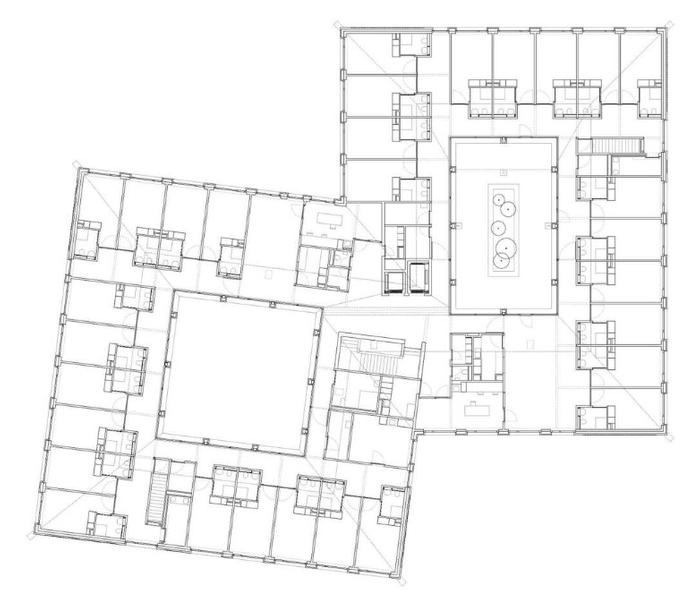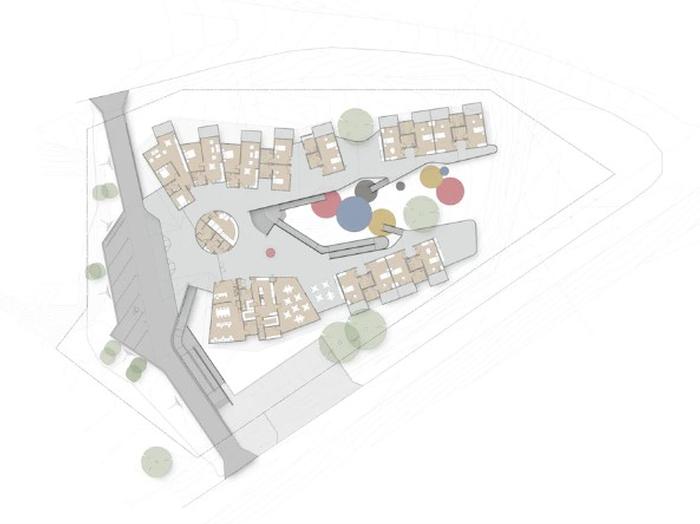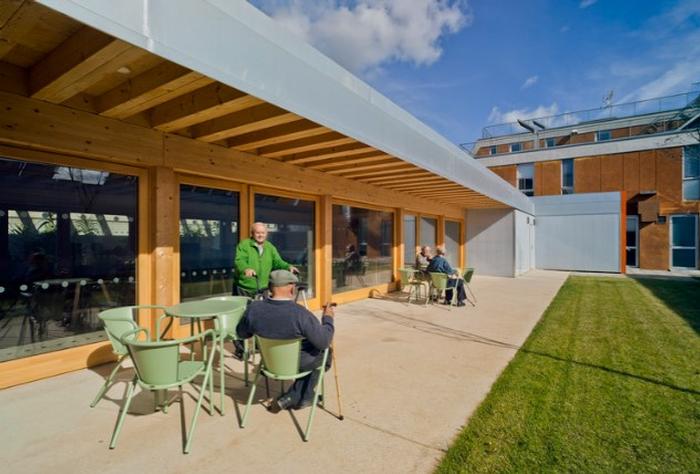[ID:4739] Housing Options for an Aging Nova ScotiaCanada Nova Scotia is an old community, with younger adults who leave the province in their search for well-paying jobs, and older adults entering the province as a place to retire and relax. The aging population of Nova Scotia is both an economic concern and a social one. In 2022, the median age in Nova Scotia was 44.2 years, the third highest of the ten provinces in Canada. Within the province, the young people are clustered in the city of Halifax (median age 39.9) while the median age in rural areas is considerably higher, with Lunenburg County at 54 years and Guysborough County at 57.8 years (Nova Scotia Dept. of Finance).
People Moving
When a young adult moves out from home and looks for work in Nova Scotia, they often leave their hometown and move to Halifax, the province’s largest city. The opposite happens when retired adults moves into and around Nova Scotia, they often choose a smaller town to have more space for their hobbies or to live their ideal life.
This means that people who need more support are moving away from cities which are better equipped with supportive infrastructure, to realize the life they dream of. This creates a design challenge. The ideal facility would accommodate not only the care needs of seniors, but also a way of life they treasure.
The Appeal of Independence
Many older Nova Scotians are reluctant to leave their home for a seniors facility. This is partly because of their perception that they are stronger in their own homes and going to an assisted care facility is a sign that they are unable to care for themselves. Living in your own house shows that you are independent and capable, able to manage your own life.
To help Nova Scotian seniors stay in their houses, the province provides supports which include home visits from nurses and social workers who ensure that the senior’s quality of life is still good. They visit, talk, and help with daily tasks such as cleaning, laundry, or cooking. Such guaranteed social time and at least one cooked meal a week, eases the burden on the seniors, helping them maintain their independence while living alone.
The Common Experience
Part of the appeal of aging in your own house is the state of most nursing homes in Nova Scotia. The move to a nursing home is often a last resort for families concerned for their older relatives.
Nova Scotian nursing homes squeeze many individual units in a large building. The best single-occupancy units are a single room with a hospital bed, some space for furniture brought in by each resident, and a small bathroom. By design, these rooms resemble hospital rooms, making it easy for caretakers but unpleasant and unfamiliar to residents. A senior accustomed to having a full house to themselves, may feel like an invalid in this style of a single room with all of their life condensed down to one space, and often can feel isolated from others due to this reduction of space and drastic change in lifestyle. Although bodily needs such as food and rest are being met, their social needs are often not — unless they are visited by family, they often remain in their rooms, only seeing the nursing home staff.
Some nursing homes include a large dining area, and some a common area for organized events such as church services, card games, or group mealtimes. While these are good for socialization, the events which are hosted inside are usually organized by staff. Seniors who remain within the same room all day may feel they do not have the ability to organize these or other social events causing these spaces to be underused if staff are unable to organize events.
Enriching lives with Engagement
Recent projects for seniors housing and assisted living complexes have started to use a senior’s perspective when designing the program and layout of the complex, especially in considering the capabilities and individuality of seniors in the design.
This is easiest to see in the layout of the living environments, as additional space is given to residents. One room is expanded to two, with an open living space, often like a conventional small apartment which allows for a living room set up that can be made by them, as well as a kitchen area which gives them more flexibility in where they want to take their meals.
Although giving seniors more space can encourage them to feel responsible to care for the space, which promotes simple activities which can extend a senior’s independence, this strategy does not always provide the best care for seniors who arrive with challenges living independently. This is where the assisted care comes in, with some housing options offering apartments which are designed to be dementia friendly, with support staff who check in and meal programs to ensure a good quality of life.
A Project Ahead of its’ Time
In Chester, Nova Scotia, the assisted care facility Shoreham Village, established in 1974, is composed of three main programs, spread over a 14-acre property, each with an individual design. The project was founded as a response to the closest assisted living facility being a half hour drive away. By creating a care home in the town of Chester, families could visit their aging relatives more easily and frequently.
When developing the criteria for the facility, the operators decided to take a resident-centered approach, designing the layout, services, and programs to support residents with varying levels of independence. This can be seen in the variety of accommodations, with the most independent being apartment buildings which the only difference from conventional condos are the age requirements to live in them, to the apartment style units connected to the main building by a board walk, the more traditional care wings for residents needing more care, and the health center to support medical staff. There is a community room on the boardwalk where apartment residents organize their own card games or social events. Having all the units open onto the boardwalk allows for easy visiting among neighbours, even by those using walkers or wheelchairs. Shoreham also attempts to be very open to residents’ families, offering open visiting and encouraging day trips and overnight stays.
Residents in the apartment units retain a greater sense of independence. They have the option to shop for their food within Chester, or have it delivered by staff for them to cook their own meals, or complete meals. The traditional wings of the facility have dedicated staff who get to know the residents, creating a more relaxing environment through stability.
The Shoreham Village staff support many different aspects of the seniors’ care, including registered dietitians and a recreation department as well as the more typical staff of nurses, physiotherapists, and other medical practitioners.
Contemporaries Within Nova Scotia
There are other projects and facilities which have been developed since Shoreham Village, which all offer care for seniors with similar objectives and methodology to the type of support provided. One such project is Drumlin Hills in Bridgewater, and another is Parkland in Halifax. These two options are very similar with Shoreham and the care programs offered to seniors, with varying levels of independent lifestyles encouraged through living environments and programming of the space. All three offer enhanced services for residents who require support in daily actives due to memory issues or other complex needs, while still having other options for seniors who wish to live around others instead of being isolated in their homes.
The largest difference between Shoreham Village and its contemporaries, is both the age of the project, with both Parkland and Drumlin Hills being established around 1999, and the form of the construction. Parkland and Drumlin Hills are built to be hotel-like buildings, with residents living in suites or small apartments on the floors above ground level, and the ground level holds many of the key activity zones such as the dinning areas, multiuse rooms, and other possible luxuries like the salon/spa within Parkland. Having a vertical construction like this is an economical use of space within a city like Halifax but introduces a variety of challenges that the row housing/ apartments of Shoreham village can avoid. These are physical challenges like evacuation issues if there is a fire, as the elevator will not function, which will cause delays in the evacuation of seniors with mobility issues, as well as environmental challenges, where seniors who are accustomed to having their own home and space must condense their living to a single area which is in closer to others than what they are accustomed to. Challenges like these are why Shoreham Village may be more attractive to seniors who still want to maintain their independence, since it is built out instead of up it does not have many stairs, the apartments are spread in a row, so remaining in close proximity they feel like more individual space since they are separate buildings, and Shoreham is located within a town on a property which maintains greenspace for the seniors to use, which creates a calmer environment for them.
Challenges to Desirable Designs
Although seniors’ perspectives should be the voice with the most weight when designing a care facility or later life housing, with the nurses and other staff just below them, this is not a typical consideration in the design of a Nova Scotian care facility, as the government who is responsible for the majority of the construction always aim to produce a large project with the smallest budget possible. Due to both the budget and time constraints which the government may place on the project, the future residents may not get to give input into what a care facility develops to. The three projects highlighted were all constructed by private groups to provide elevated care for seniors, so benefited from both the knowledge of the field that the client group had as well as more flexibility in project budgets and timelines for design and building.
Additionally obtaining land for a project the scale of Shoreham Village is more expensive to obtain, so new design responses for assisted care facilities have to innovate higher density housing for seniors which will still provide the same perceptions of independent and welcoming environments with less space or have to face inflated budgets. More thought should be given to the ethos of care facilities within Nova Scotia, as the people in charge of new developments should plan to build a place which they would be happy to live in, as the needs of people remain consistent throughout most stages of life.
Conclusion: To Treat Seniors as People
Within the world there are many seniors who all have different wants and needs, but as they age, they are less able to care for themselves. This should not lessen their value within society, to where they are given small and cramped accommodations as their only option for receiving care. Over their life they have experienced many things which they should have the opportunity to pass down to the next generations, which is only possible by providing them a welcoming and comforting environment where they feel engaged and respected.
This can be obtained by giving them a space where they are able to maintain their individuality and independence, while still being able to access a care network when they need it. The care facilities must recognize when they should have interventions to provide care for a senior while still being able to maintain a distance that allows the seniors to feel competent and engaged within a community that allows them to pass on their knowledge. The idea that there is a balance between a senior’s sense of self and their dependence on others to care for them has been around for almost half of a century within Nova Scotia alone. It should be embraced by communities as a way to interact with and learn from older generations, and as a way to promote healthy living and engagement within elderly populations.
References:
“Nova Scotia Department of Finance - Statistics.” 2020. Government of Nova Scotia, Canada. December 17. https://novascotia.ca/finance/statistics/archive_news.asp?id=16471#:~:text=Looking%20at%20the%20distribution%20of%20population%20across%20age,to%20Nova%20Scotia%20among%20both%20males%20and%20females.
2016. Shoreham Village. Shoreham Village Home for Special Care. https://www.shorehamvillage.com/.
https://experienceparkland.com/en/locations/parkland-clayton-park/
If you would like to contact this author, please send a request to info@berkeleyprize.org. |




